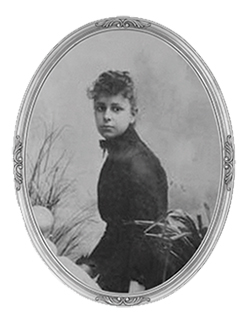
Florence Parker was known to her adoring nephews as Aunty Puff; they were page boys when she married Ernest Edward Truby Williams in October of 1897. Aunty Puff and Truby shared a love of travel and he kept meticulous travel journals from the year of their wedding until his last overseas trip to India in 1937.
The wedding was reported in detail in the Melbourne Punch newspaper on Thursday 21 October 1897. The Church (Christ Church in South Yarra) was ‘artistically decorated by the girl friends of the bride with arches of white flowers, a large wedding bell’. No detail of Aunty Puff’s wedding gown was left out – she wore “… a handsome ivory duchesse satin gown, lined with pretty pink silk… embroidered in silver, transparent sleeves and yoke of drawn chiffon ; the long embroidered veil was tastefully draped over real orange blossoms; she wore a pearl and diamond ring, the gift of the bridegroom; the bouquet was of white lilac, azaleas and lilies of the valley, with streamers of white satin, with the initials of the bride and bridegroom in silver…”
Florence, who had been born Melbourne in 1870, and was living with her family at ‘Almeida’ on Toorak Rd in Toorak, was given away by her father, Thomas James Parker and accompanied by two of her sisters – Adah and Marion (May). The Parkers were, by all accounts, a well-to do family, with Thomas arriving in Australia from London to make his fortune as a merchant and ship owner.
Florence was the youngest of 8 children – only three survived to adulthood; a brother Ernest, and her sister Adah – who was in charge of the wedding reception at the family home. After their mother, Mary Anne Clifford died in 1873, Thomas remarried – this time to Marion Elizabeth Hollings. Thomas and Marion had two more children – but only May, who was a part of the bridal party, survived. Marion died in 1887.
When Thomas died in April 1900, he left his his family (including his own siblings and extended family) very well cared for financially. The family had assets across Victoria, including in Melbourne and Geelong where they had many connections and interests.
The family connections – and their gift choices – were well on display at Florence’s wedding. All guests, and the gifts they gave to the bride and groom, were included in the newspaper report of the wedding!
That day, the groom received from his bride the gifts of a pearl stud and a travel bag (he had given her a pearl and diamond ring).
Truby was from a respectable Melbourne family. He was born to James Williams and Mary Jane Thomson) and went to Scotch College – as did his four brothers (it is unknown how many siblings there were but records show he had at least six. One died in WW1 aged just 25).
The name ‘Truby’ comes from his maternal side. His grandmother’s maiden name was Hannah Truby. Both of Truby’s maternal grandparents lived to see their grandson marry Florence Parker that day in 1897 – Hannah died in 1903, while grandfather James Thomson died in 1899.
Aside from a passion for travel, Truby, who was described as ‘a merchant in investor’ was also keenly interested in the arts, and the (then) burgeoning field of motor vehicle technology.
Aunty Puff died in 1918 aged just 48. When Truby died in 1941, aged 75, he left behind the Truby and Florence Williams Charitable Trust with £200,000, and bequests to (as they were named at the time in the order listed in the Will): Swinburne Technical College, The Alfred Hospital, Melbourne Technical College, Royal Melbourne Hospital, Melbourne University, Melbourne University Conservatorium of Music, The Women’s Hospital, The Austin Hospital for Cancer and Chronic Diseases, The Children’s Hospital, The Melbourne District Nursing Society, The Melbourne Benevolent Asylum & Hospital for the Aged & Infirm, The Central Mission Boys Training Farm and the Victorian Bush Nursing Association.
The Trust is now valued at more than $19 million and distributes $600,000 annually to a variety of organisation, including the world leading NGV Kids program.
The NGV program as supported by the Trust from inception in 2013, and has meant the NGV now has a permanent children’s gallery space, dedicated children's programs and curatorial staff. The program has included initiatives such as the publication of fourteen children's art books, the popular Art Party event for teens, as well as commissioning thirteen major exhibitions for families and young people.